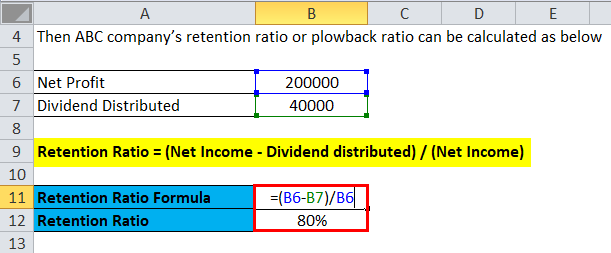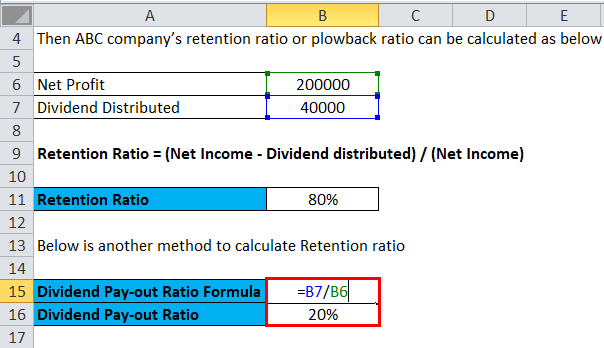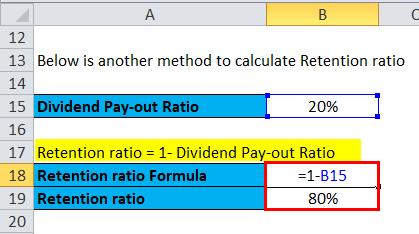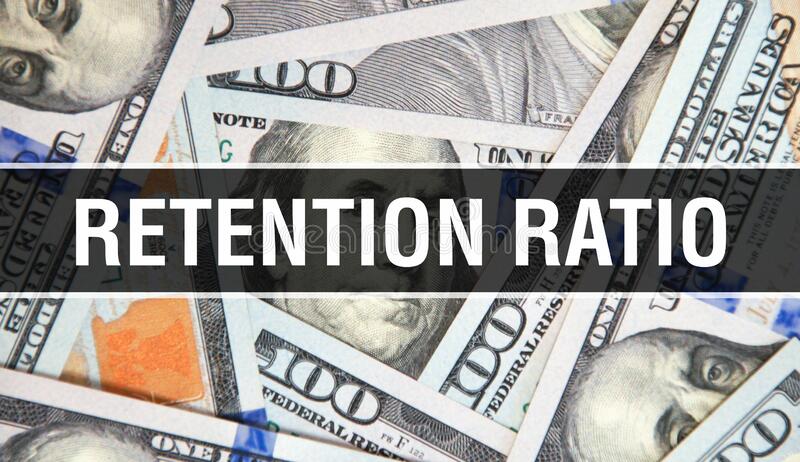Ratios as a financial tool can be looked at over a period of time. It makes it easier to compare one company to another in terms of their earnings retention. In addition, it enables analysts to evaluate changes in the company’s performance over a given time interval. So in this article, we will be looking at the definition of retention ratio, retention ratio formula, how to calculate retention ratio with examples. We will also look at the retention ratio calculator.
What is the Retention Ratio?
The retention ratio is the ratio of the income a company retains to its net income. We also refer to it as the net income ratio or plow back ratio.
It is the part of the profit that the company keeps instead of paying profits out as dividends. It is the opposite of the payout ratio. The payout ratio + the retention ratio will equal 100%.
Furthermore, the retention ratio is the part of net income set aside to fund the working needs of a business. A high retention level shows that the business has more use for the cash internally. This implies that it provides a rate of return higher than the cost of capital. A low retention level means that most earnings are being shifted to investors in the form of dividends.
Interpreting the Retention Ratio
A high retention ratio may not always be a sign of financial health. So, to better understand the ratio, we must first understand the company that we are calculating its ratio.
However, smaller, newer companies will normally report higher ratios. Smaller businesses often focus on business development and investments in research and development (R&D). As a result, they will likely retain their earnings rather than share them as dividends. A startup business may also be having slow sales in the early stages of business. This would mean that there is less profit to share to shareholders, thus resulting in a higher ratio.
Bigger companies will usually post lower retention ratios, as they are already in profits. Hence, they do not need to invest as heavily in R&D. Thus, such companies may opt to pay investors regular dividends in preference to retaining more earnings.
This ratio is used by growth investors to locate those companies that appear to bring money back into their operations. They work on the basis that this will increase their stock price. This use of the ratio may be incorrect in cases where company management expects a business will go down. The company can keep extra funds simply to prepare against the bad times that are expected later on.
However, there are many reasons that companies can have high or low retention ratios. Below are some cases;
Companies with low plow back ratios:
#1. Value-orientated companies.
#2. Where the board and management may own stock and pay dividends to themselves.
#3. Companies that do not have any worthy investment.
Companies with high plow back ratios:
#1. High growth company; they use the money to invest in other projects.
#2. Companies that do not have positive cash flow or earnings.
Retention Ratio Formula
There is a simple method for calculating the retention ratio: divide a company’s retained income by its net income. The formula below shows the steps involved:
Net income can be seen at the bottom of a business’s income statement. We can find the dividend figure in the shareholder’s equity section of the balance sheet. Also, we can see it in the financing section of the cash flow statement.
We can calculate the ratio on a per-share basis, using the following formula:
Retained earnings are shown in the numerator of the formula as net income minus dividends.
This formula is an important part of other financial formulas, especially growth formulas. It also looks at how much a company will keep, instead of being paid out to stock shareholders. Whatever amount the company retains, will be reinvested for growth in the company. Hence, the company’s retained earnings are an opportunity cost of paying dividends for stockholders to invest elsewhere.
Also, another alternate formula is;
Retention Ratio = 1- pay out ratio.
The payout ratio is the number of dividends the company pays out divided by the net income. Hence, this formula can be rearranged to show that the retention ratio plus payout ratio equals 1, ie 100%. Therefore, the amount paid out in dividends plus the amount kept by the company is the total of all the net income.
Retention Ratio Example
We are going to be looking at a few retention ratio examples to help us know the plow back ratio
Example 1.
Ned’s Company earned $100,000 of net income during the year and decided to share $20,000 of dividends to its shareholders. Here is how ned will calculate his plow back ratio.

Here, Ned’s rate of retention is 80%. In other words, Ned keeps 80% of his profits in the company. Only 20% of his profits will be given to shareholders. Depending on his industry this could be a standard rate or it could be high.
Example 2.
ABC Company earned $200,000 of net profit during the financial year. The company gives out profits of $60,000 to its shareholders.
The following shows how to calculate the plow back ratio.
Retention Ratio = (Net Income – Dividend ) / (Net Income)
Retention Ratio = ($200,000 – $60,000) / $200,000
Plow back Ratio = 70 %
Or,
Dividend Pay-out Ratio = 60,000 / 200,000
Dividend Pay-out Ratio = 30 %
Plow back Ratio = 1 – Dividend Pay -out Ratio
Plow back Ratio = 1 – 30 %
Retention Ratio = 70 %
From the retention ratio example above, ABC company’s retention rate is 70%. In other words, ABC keeps 70% of its profits in the company. Only 30 % of its net profit will be given to shareholders as profits. 70 % of the net profit is kept in the business. Consequently, it shows the business is in a growth stage. Thus, we will need more capital for future growth. However, one ratio is not enough to jump to the conclusion.
Example 3.
Company XYZ has a net profit of 100,000 during the financial year FY 2019. The management decides to share a profit of 60,000 with its shareholders.
We can calculate XYZ company’s retention ratio or plow back ratio using the formula as below –
| Net Profit | 100000 |
| Dividend Distributed | 60000 |
Dividend Pay-out Ratio = 60,000 / 100,000
Dividend Pay-out Ratio = 60 %
Retention Ratio = 1 – 60 %
Retention ratio = 40 %
We can also calculate it by putting direct values into the formula
Retention Ratio = (Net Income – Dividend distributed) / (Net Income)
Retention ratio = ($100,000 – $60,000) /$100,000 = 40 %
Company XYZ retains 40 % of the total profit and shares 60 % of the profit. Hence, there is slow growth in the company’s business. Otherwise, the company doesn’t need more cash for its future growth. We can also use the retention ratio calculator to calculate the plow back ratio.
Retention Ratio Calculator
The Retention Ratio Calculator is a web tool used to calculate the retention ratio. You can use the Retention Ratio Calculator as below
| Retained Earnings | |
| Net Income | |
| Formula | |
| Retention Ratio Formula | = | Retained Earnings=Net Income | 0=00 |
Retention Ratio Formula in Excel (With Excel Template)
Here we will do the same example of the Retention Ratio formula in Excel. Also, it is very easy and simple. You need to provide the two inputs i.e net income and dividend shares.
You can easily calculate it using Formula in the template below.


Then we can calculate the Retention ratio from the dividend Pay-out ratio value.

Factors that Affect the Retention Ratio
- A company growing needs additional cash to finance investment in tangible and intangible assets. It also needs additional cash in marketing activities to get a larger customer base.
- A company looking to takeover opportunities that will help in its growth plans will have a higher ratio.
- When a company has taken too much debt, it may hold back cash to pay the debt. Thus, this can improve its financial risk profile.
- Companies like automobiles, oil production & refining, telecommunication, needs large amount of money to maintain their level of production. So, this type of industry calls for higher ratio.
Advantages of the Earnings Retention Ratio
- One of the greatest advantages of the plow back ratio is that is a very easy formula to understand.
- Additionally, we can calculate the ratio in many ways as there are plenty of formulas you can use.
Disadvantages of the Earnings Retention Ratio
- Shareholders investing in a company understand that the higher the ratio, the growth of the company also increases. Hence, raising the prices of the shares as well. Thus, it is a concern the shareholders might want to control their shares they have invested in the company. As a shareholder of the company, he might not think that there are many advantages of ratio.
- The ratio does not always indicate a good financial health of a company. Companies with lower earnings may pay less or no dividends to its shareholders, thus resulting in a high ratio.
- Also, the ratio does not show whether the company is putting the funds back into the company or not.
- The ratio also fails to capture whether the retained capital has been reinvested. Also it does not show whether such reinvestment is done well.
The Retention Ratio’s Limitations
The retention ratio has a constraint in those corporations with a big amount of retained earnings would generally have a high retention ratio, but this does not necessarily suggest the company is investing those assets back into the company.
Furthermore, a retention ratio does not account for how the money is invested or whether any investment back into the company was made efficiently. It is ideal to use the retention ratio in conjunction with other financial measures to analyze how successfully a company invests its retained earnings.
As with any financial ratio, it’s critical to compare the results to companies in the same industry and to track the ratio over multiple quarters to see whether there’s a trend.
Can a high retention ratio guarantee success for a company?
A high retention ratio is a positive indicator for a company, but it does not guarantee success on its own. Other factors such as revenue growth, profitability, and customer acquisition also play important roles in a company’s success.
How does customer satisfaction impact retention ratio?
Customer satisfaction is a major factor in determining retention ratio. When customers are satisfied with a company’s products or services, they are more likely to continue doing business with the company, leading to a higher retention ratio.
How does pricing affect retention ratio?
Pricing can have a significant impact on retention ratio. If a company’s prices are too high, customers may choose to switch to a competitor, leading to a lower retention ratio. On the other hand, if prices are too low, the company may not be able to sustain its business, also leading to a lower retention ratio. Striking the right balance between price and value is crucial for retaining customers.
What role does competition play in retention ratio?
Competition can have a significant impact on retention ratio. If a company’s competitors offer better products or services at a lower price, customers may switch to the competitor, leading to a lower retention ratio for the original company. It is important for companies to constantly evaluate and improve their offerings in light of competition.
What are some best practices for measuring and improving retention ratio?
Some best practices for measuring and improving retention ratio include regularly tracking and analyzing customer behavior, gathering customer feedback, implementing customer loyalty programs, improving product quality, and offering competitive pricing. Companies can also consider using technology, such as customer relationship management (CRM) software, to track and analyze customer data.
How does retention ratio differ for B2B and B2C companies?
Retention ratio can differ for B2B and B2C companies due to the nature of their respective business models. B2B companies typically have longer sales cycles and stronger relationships with their customers, leading to a higher retention ratio. B2C companies, on the other hand, may face more competition and have a higher volume of customers, leading to a lower retention ratio.
How can a company improve its retention ratio?
A company can improve its retention ratio by regularly gathering and analyzing customer data, improving product quality, offering competitive pricing, implementing customer loyalty programs, and providing excellent customer service. Companies can also consider using technology, such as customer relationship management (CRM) software, to track and analyze customer behavior and gather feedback.
Conclusion
So, in conclusion, the retention ratio is a fundamental analysis tool that shows the amount of profit that is put back into the business for its growth of the business. Also, investors may prefer a capital increase over dividend payments if the company has high growth indices. However, the ratio, just like any other, should not be studied alone but together with other financial tools. Moreover, it should be observed over a period of time to rightly check the performance of the company.
Retention Ratio FAQs
What is Retention Ratio?
The retention ratio is the percentage of earnings that are kept in the business as retained earnings. The retention ratio is the percentage of net income that is retained to grow the business rather than paid out as dividends.
What is the retention ratio formula?
As previously stated, the calculation is retained earnings divided by net income. The 90 percent retention ratio indicates that net of any dividends paid to equity shareholders, 90 percent of the company’s net earnings are held and accumulated on its balance sheet to be spent at a later date.
What is a good ratio for retained earnings?
The ideal retained earnings-to-total-assets ratio is 1:1, or 100 percent. This percentage, however, is very hard for most organizations to reach. As a result, a more attainable goal is to have a ratio as near to 100 percent as possible, which is above average in your business and improving.






